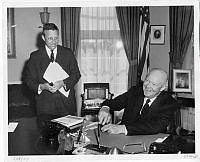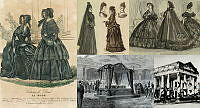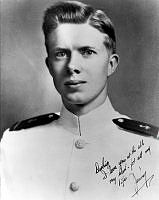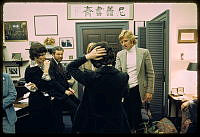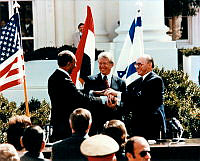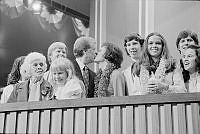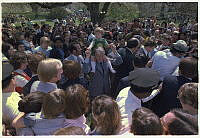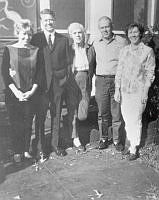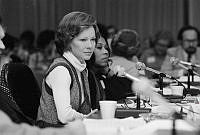Fourth of July Celebrations at the White House in the 19th Century
Copyright © White House Historical Association. All rights reserved under international copyright conventions. No part of this article may be reproduced or utilized in any form or by any means, electronic or mechanical, including photocopying, recording, or by any information storage and retrieval system, without permission in writing from the publisher. Requests for reprint permissions should be addressed to books@whha.org

South view of the White House, 1855.
- The People's House: Although John Adams was the first to occupy the Executive Mansion in November 1800, it was Thomas Jefferson who first celebrated the Fourth of July at the White House in 1801. Jefferson opened the house and greeted diplomats, civil and military officers, citizens, and Cherokee chiefs in the oval saloon (today’s Blue Room). The Marine Band played in the Entrance Hall while on the north grounds a festival took place—complete with horse races, parades, and food and drink. The tradition of an annual reception at the White House continued for much of the nineteenth century.
- Parades: John Quincy Adams often celebrated the holiday by joining a procession to the Capitol before returning to the White House to receive the public. For John Quincy Adams, the Fourth of July was bittersweet. His July 4, 1827 diary entry reveals: “The day had for the first time a threefold interest of glory of joy and of melancholy which mingled in all my recollections—as the day of Independence as my son John’s birthday, and as the day of my father’s decease.” His father, President John Adams, along with President Thomas Jefferson, had both passed away on July 4, 1826, the fiftieth anniversary of the Declaration of Independence.
- Turtle Soup: In a diary entry for July 5, 1841, Massachusetts Representative and former President John Quincy Adams mentioned attending a private dinner at the White House with President John Tyler to celebrate the anniversary of American independence. Adams wrote, “There was turtle soup from a turtle weighing 300 lb a present from Key West.” President Tyler ended the evening watching fireworks with his guests from Lafayette Square.
- A Fatal Fourth: In 1850, President Zachary Taylor fell ill after drinking ice water and eating cherries while attending the Independence Day celebrations at the Washington Monument. He died five days later from a gastrointestinal illness (perhaps cholera), which was not uncommon in D.C. before the advent of modern plumbing and sewage.
- A School Festival: In 1864, amid the turmoil of the Civil War, President Abraham Lincoln attended a picnic for African American schools and churches, as well as religious groups on the Fourth of July. He allowed these groups to hold the event on the White House South Grounds, in between the War Department and the President’s House, setting an example of tolerance for the rest of the country. During the event, participants listened to a recitation of the Declaration of Independence.
- A Summer Concert: The Marine Band performed weekend summer concerts on the south grounds of the White House from June to September for many years. In 1886, Grover Cleveland and his new bride Frances Folsom made an appearance on the South Portico at a Fourth of July concert. The crowd rushed to get a view of the new first lady. As the president saw the huge crowd approaching, he waved to them with his straw hat and hurried Mrs. Cleveland indoors. The crowd then flocked back to the concert.

July 4, 1868 Harper's Weekly cover shows a crowd gathered on the South Lawn of the White House.
White House Historical AssociationPresidential & First Lady July Birthdays:
- July 11, 1767 - John Quincy Adams; Braintree (now Quincy), Massachusetts
- July 25, 1775 - Anna Harrison; Morristown, New Jersey
- July 21, 1864 - Frances Cleveland; Buffalo, New York
- July 4, 1872 - Calvin Coolidge; Plymouth Notch, Vermont
- July 14, 1913 - Gerald R. Ford; Omaha, Nebraska
- July 6, 1921 - Nancy Reagan; New York City, New York
- July 28, 1929 - Jacqueline Kennedy; Southampton, New York
Prominent July Deaths:
- July 4, 1826 - John Adams; Quincy, Massachusetts
- July 4, 1826 - Thomas Jefferson; Charlottesville, Virginia
- July 4, 1831 - James Monroe; New York City, New York
- July 9, 1850 - Zachary Taylor; Washington, D.C.
- July 24, 1862 - Martin Van Buren; Kinderhook, New York
- July 31, 1875 - Andrew Johnson; Carter's Station, Tennessee
- July 16, 1882 - Mary Lincoln; Springfield, Illinois
- July 23, 1885 - Ulysses S. Grant; New York City, New York
- July 10, 1889 - Julia Tyler; Richmond, Virginia
White House Wedding:
July 30, 1942 - Harry Hopkins (assistant to President Franklin D. Roosevelt) married Louise Gill Macy in the Second Floor Oval Room (then the President's study).














